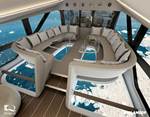Airlander electric propulsion project wins grant funding
UK Aerospace Research and Technology Programme awards grant to develop electric propulsion for Airlander 10.
A partnership of Hybrid Air Vehicles Ltd. (HAV, Shortstown, Bedford, U.K.), Collins Aerospace (West Palm Beach, Fla., U.S.), and the University of Nottingham (Nottingham, U.K.) has won grant funding in excess of £1m from the U.K. Aerospace Research and Technology Programme to develop electric propulsion technologies using Airlander 10 as the initial platform.
The project, named E-HAV1, aims to deliver a full-sized prototype 500kW electric propulsor for ground testing and technologies ready for future production. These technologies will be directly applicable to a future Airlander 10, with the goal of replacing its fuel-burning forward engines as the first step towards an all-electric version of the aircraft.
Utilizing a combination of buoyant lift from helium, aerodynamic lift, and vectored thrust, Airlander 10 is said to already operate with a significantly lower fuel burn than other aircraft of similar capability. The integration of electric forward propulsors will reportedly increase this advantage.
For a look at composites on the Airlander 10 read CW contributor Sara Black’s “Luxury travel by airship returns.”
Each of the project partners voices a commitment to sustainable aviation.
“Reducing our carbon footprint is one of the biggest challenges facing aviation today,” says HAV’s CEO Stephen McGlennan. “While Airlander 10 is already helping customers rethink the skies with incredible efficiency, we have to find ways of further reducing the impact we have on our environment. This project will move us closer to our goal of zero-carbon aviation.”
“Together, we’re developing innovative technologies that will pave the way for the hybrid-electric and all-electric aircraft of the future,” says Marc Holme, Motor Drive Systems Engineering director at Collins Aerospace, about the partnership.
Prof Pat Wheeler, Head of the University of Nottingham’s Power Electronics, Machines and Control Research Group, adds, “We are really looking forward to the exciting challenges of applying our technological knowledge of electrical machines, power electronics and power systems to the Airlander propulsion application. This project will also benefit from the UK Research Partnership Investment Fund (RPIF) investment in our new Centre for Power Electronics and Electrical Machines, which will open early in 2020.”
The E-HAV1 project is supported by the UK’s Aerospace Technology Programme, which is delivered through a partnership between the Aerospace Technology Institute (ATI, Bedfordshire, U.K.), the Department for Business, Energy & Industrial Strategy (BEIS, London, U.K.) and Innovate UK (Swindon, U.K.).
Related Content
-
The potential for thermoplastic composite nacelles
Collins Aerospace draws on global team, decades of experience to demonstrate large, curved AFP and welded structures for the next generation of aircraft.
-
Manufacturing the MFFD thermoplastic composite fuselage
Demonstrator’s upper, lower shells and assembly prove materials and new processes for lighter, cheaper and more sustainable high-rate future aircraft.
-
Plant tour: Albany Engineered Composites, Rochester, N.H., U.S.
Efficient, high-quality, well-controlled composites manufacturing at volume is the mantra for this 3D weaving specialist.













